Growth Hacking Best Practice Guide
The What, Why and How of Growth Hacking
Introduction to growth hacking
When most people hear the word hacking, they think of something bad.
Scott Brinker, author, Hacking Marketing
This seems natural enough. There are many media stories and movies that feature hackers manipulating government systems and holding people’s personal data to ransom.
There’s actually another, more positive meaning of the word hacking. In software development, hacking is the art of invention, says Scott Brinker in his book HackingMarketing. In a business context, rather than describing malicious intent to break into a system, hacking can also be used to describe a methodology accelerating business growth.
This LXA report is designed to introduce marketers to the concept of growth hacking. We will outline what growth hacking is and what makes it different to traditional marketing methods.
This will involve deconstructing some of the trends that have impacted the marketing profession in recent years, namely ubiquitous connectivity, availability of data, and the
need to invest in and deploy marketing technology.
These trends have, in turn, facilitated an increasingly competitive landscape whereby startups, unencumbered by legacy systems and ways of doing business, can both challenge the market share of incumbents and also create brand-new markets.
Famous examples include Airbnb, Netflix and Dollar Shave Club. We will look at some of these examples, and outline some of the frameworks that can be used to start thinking like a growth hacker, and building a growth hacking mindset in your organisation.
The origins of growth hacking
Growth hacking was first introduced as a term by the entrepreneur and startup advisor Sean Ellis, Founder and CEO of GrowthHackers, to describe an approach to marketing that seeks to acquire as many customers as possible, as quickly as possible, by using creative
and low cost tactics that link marketing and technology, particularly data, social media and machine learning.
Ellis used these tactics most famously at Dropbox, helping to drive rapid adoption of the service.
Since then, countless other startups that required a lean and agile approach to unlocking growth have adopted this process to grow their business with similar trajectories.
Growth Marketing has now become a well-established methodology. In today’s landscape, organisations that don’t embrace growth marketing are at risk of being outmanoeuvred by smaller, more agile companies, as well as by established companies which adopt growth
strategies.
The process of growth hacking
Even if firms have an idea of what growth hacking is, they may still be puzzled as to how to
do it, creating a gap between strategy and execution.
To start with, growth hacking is not a prescriptive process. Rather, growth hacking follows
a lean philosophy rooted in agility, frequent step-by-step experimentation and testing in
an iterative process. In this sense, growth hacking encourages marketers to quickly test
tactics which can be accepted or ruled out.
Typically, the tactics that are deployed are digital, cost effective and require as little resource
as possible. By definition, the goal is to grow and retain an active customer base as quickly
as possible.
10 key features of a growth hacking approach
Creative
By its very nature, growth hacking is creative, as it seeks to find new ways to solve old
problems. Creativity and innovative thinking is essential for growth hackers to find solutions
for problems, create new products and campaigns, and find new ways to drive growth.
User focused
Growth hacking is focused on the user/customer throughout the process of product design
right through to marketing. Typically involving iterative product development processes
which involves testing and user feedback from the beginning.
Goal oriented
Growth hacking focuses on tactics that help deliver measurable business growth. Growth
hackers are driven by specific KPIs, such as user growth, more revenue and improved
customer retention. A focus on these KPIs can drive rapid growth.
Agile
Growth hacking needs to be agile, adapting working practices around growth initiatives,
and the ideal growth hacker knows how to set growth priorities, identify channels for
customer acquisition, measure success, and scale growth.
Fast
One common factor in growth hacking, whatever the range of tactics used, is speed of
execution. The long-term goal is growth, so growth hackers will hypothesise and test
innovative growth strategies, abandoning them quickly if they fail to produce results.
The process of growth hacking is focused and based around fast experimentation, less
resource intensive, and therefore reduces development costs.
Experimental
The process of growth hacking is based around frequent testing and experimentation.
This includes experimenting with different marketing tactics, advertising efforts, web
design decisions, and other tasks to quickly convert leads and generate sales.
Cross-functional (collaborative)
Growth hacking touches all areas of the business, and forces greater collaboration between
teams and a recognition of common business goals.
While larger businesses are typically organised into departments which separate disciplines
like marketing, product development, and data science, startups enjoy the advantages
that come with smaller teams and limited resources. They are therefore more able (even
compelled) to adopt a collaborative approach.
However, the growth hacking mindset can be applied to a business of any size, even if the
challenges may be greater.
Data-driven
The whole growth hacking approach is results oriented and requires analysis of data and
customer feedback. This approach provides insights into what drives the best business
outcomes.
It’s a process of building first, measuring the effects of the product to consumers and the
market. After that, learn and build each single time taking into consideration the metrics
you have measured and that customer feedback.
Low cost
A growth hacker uses creative, low-cost tactics to help businesses acquire and retain
customers. As the process of growth hacking is based around fast experimentation, it is
less resource intensive, and therefore reduces development costs.
Technology enabled
Growth hacking is made more efficient through the effective use of technology. This
includes areas such as testing, where tech enables marketers to experiment at scale, or to
view customer behaviour across multiple channels.
Automated
The main benefit of marketing automation is that it lets growth hackers focus on meaningful
and creative tasks, rather than wasting their time on repetitive and time-consuming work.
Growth hacking frameworks
It’s useful to think about frameworks for growth hacking, and how it can be applied to your
company.
A structured approach is one which will create the most effective growth for your business,
and a framework is a useful way to begin.
In this section, we’ll look at where growth hacking fits into your product and marketing
approach, how it differs from traditional marketing, and lay out a seven step process for
developing a growth hacking strategy.
The relationship between growth hacking and marketing
As this framework illustrates, growth hacking sits at the intersection between marketing
techniques, uses of data analysis and testing, the tech used to create the experiences and
automate processes for the customer, and encompasses the lean startup philosophy.
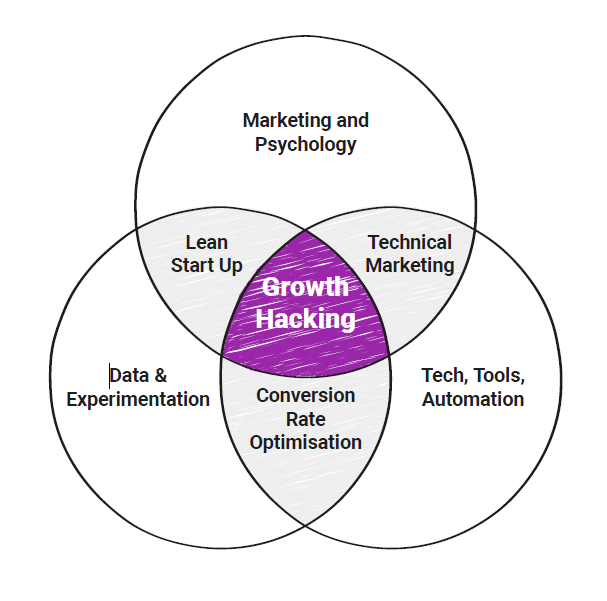
Like digital marketing in general, growth hacking has been driven by digital transformation.
The lower entry barriers to the market provided by digital channels, and the potential for
rapid growth has meant that previously well-established companies have been blown out
of the water by digital competitors. Think Blockbuster and Netflix, and some of Amazon’s
traditional retail rivals.
While a marketer’s aim is to raise awareness of, and to sell their product or services to their
target audience, the growth hacker’s is slightly different.
A growth hacker is a person whose true north is growth. Everything they
do is scrutinised by its potential impact on scalable growth.
Sean Ellis, Author, Hacking Growth
There are other differences, in terms of approach, the scope of their role, and skill sets, as
detailed below.
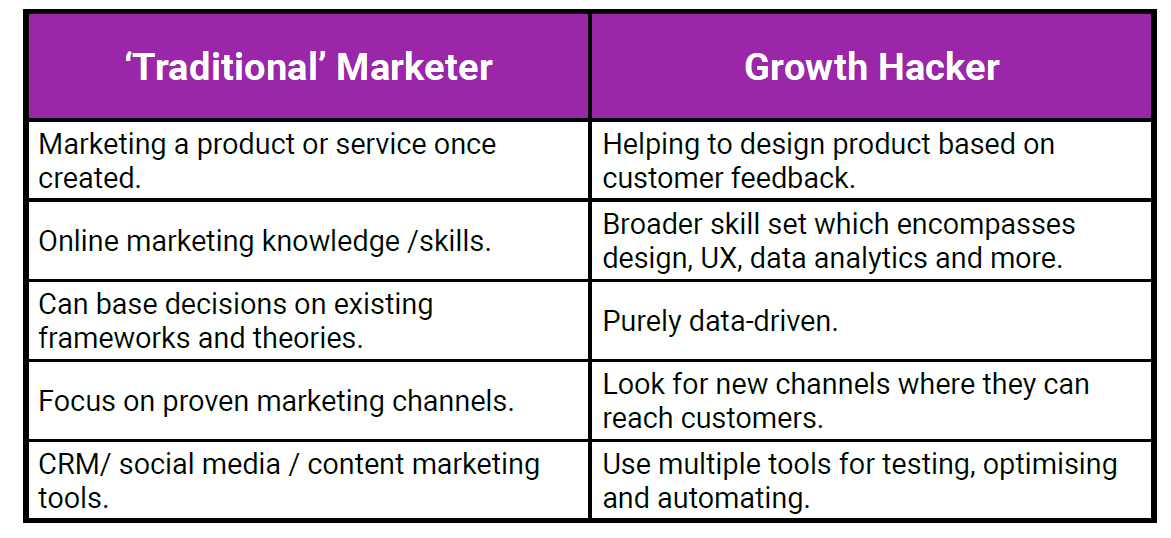
The overriding difference between the two is that, with a clear focus on growth, the role of
the growth hacker involves them in all areas of the business and the product development
process.
The marketer has a more defined role, at least in theory, though the modern digital marketer
should also have an eye on areas such as retention and revenue.
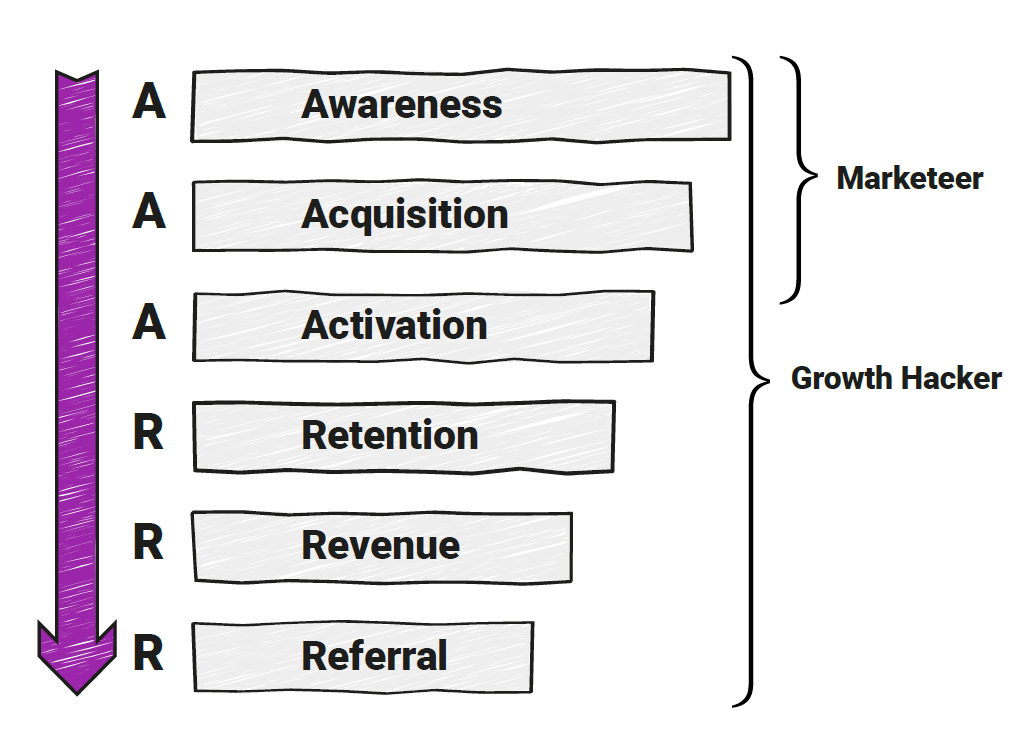
Growth hacking: a five step framework
Author and entrepreneur Sean Ellis created a Growth Pyramid, which takes into account
the necessary steps to create a company-wide culture of growth.(3)
Rather than operating in silos, with reliance upon marketing teams to drive growth, this
company-wide growth culture, with the willingness to innovate and experiment, is what can
make growth hacking successful.
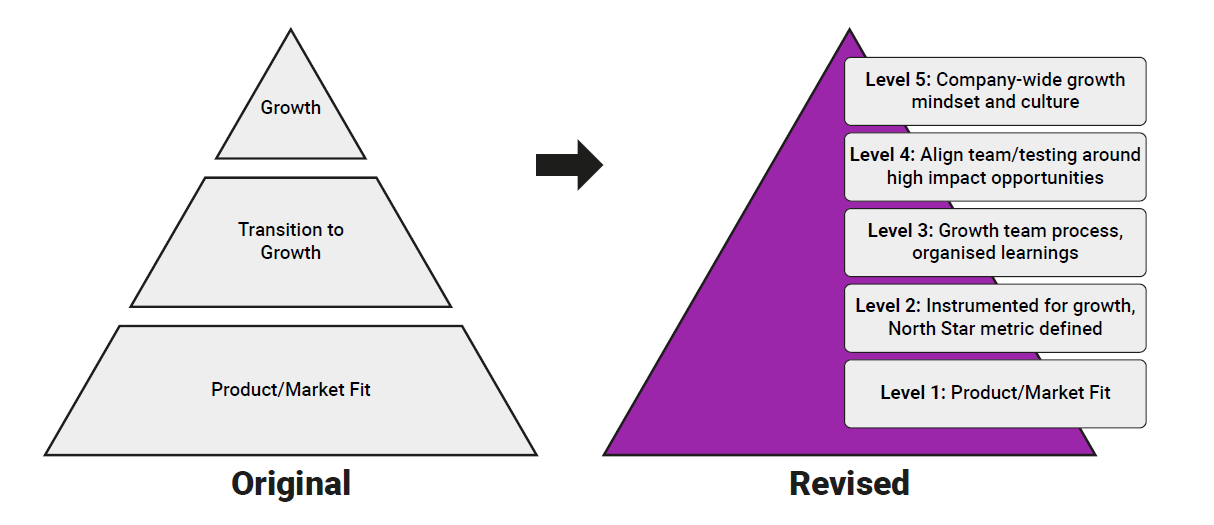
Sean’s framework outlines five steps:
1. Product/ market fit
At the heart of growth hacking is product-market fit, which simply means being in a market
with a product that can satisfy potential customers. Without starting with this premise, it
will be difficult to scale growth, as there will not be enough potential customers willing to
purchase, use and tell others about the product.
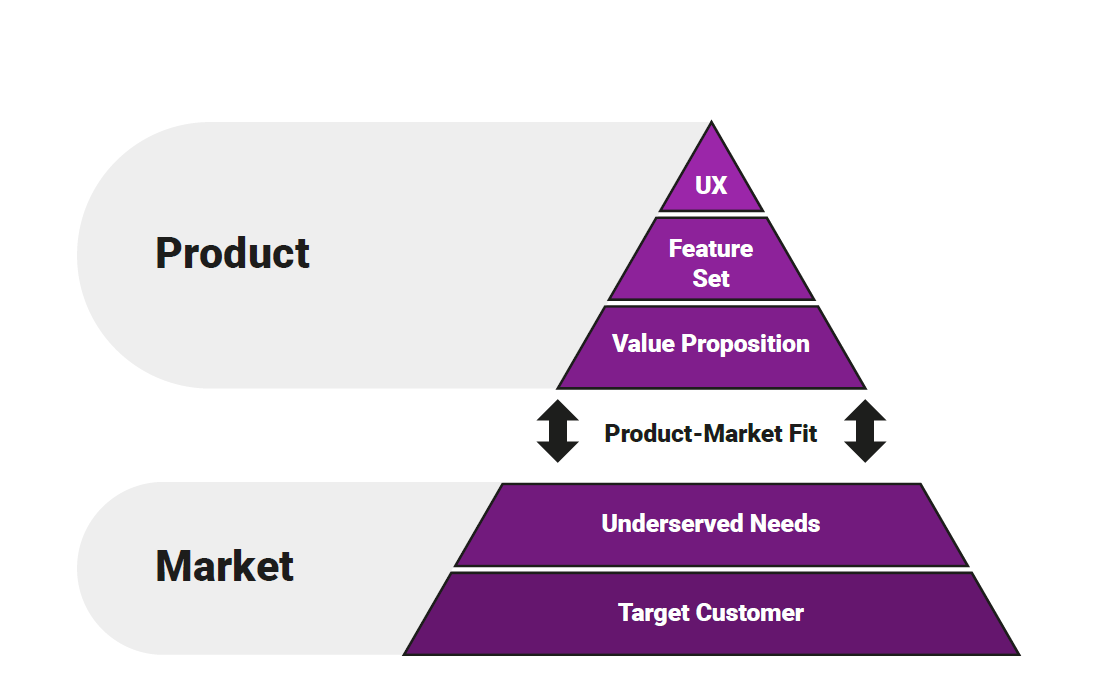
According to entrepreneur and investor Marc Andreesen, who is often credited with
developing the concept, product-market fit means finding a good market with a product
capable of satisfying that market.
Businesses that don’t achieve product-market fit need to rely heavily on paid advertising
and can get stuck in a cycle of slow or limited growth. This is the antithesis of growth
hacking.
It’s a process which thinks about consumer behaviour and demand first, and helps startups
to be faster, less-risky ventures.
As Marc Andreessen says, this must begin with a product that the market wants :
... it is impossible for an initiative to be successful unless it complies
with product/market fit. Thus, it is not only a necessity for your idea to
be in harmony with the market, but it is also a must. No matter how good
or farsighted your idea is, it will not be sustainable if it does not fit the
market.
Marc Andreessen, co-founder, Andreessen Horowitz
2. Define a north star metric and become an instrument for growth
It’s important to have an overall success metric in place to gauge the success of any growth
strategy. Whatever companies choose as their guiding metric, all energy and brainpower
should flow in that direction. The exact metric may vary according to the business type, but
it should accurately capture the core value you create for customers.
To put this into context, here are some examples of north star metrics that were used by
some well known growth-stage companies.
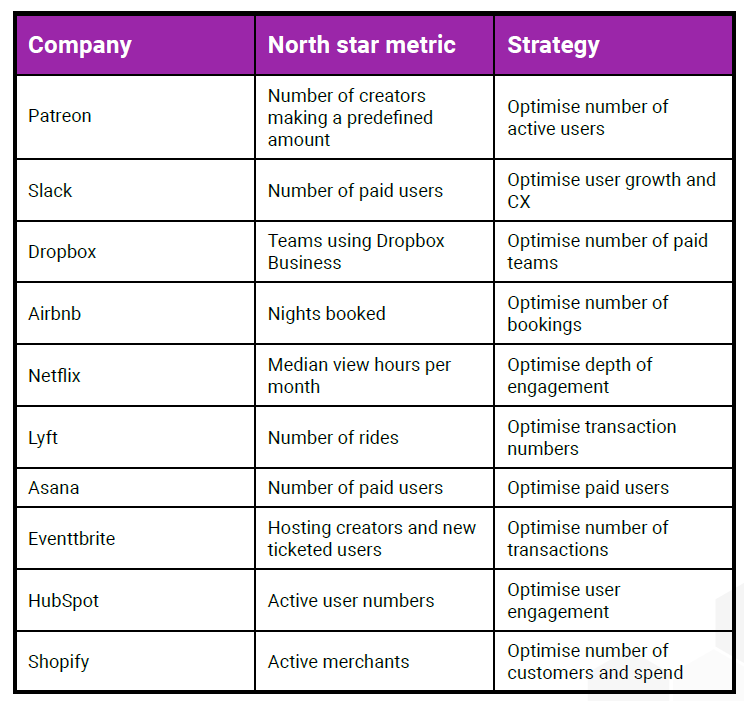
3. Growth team, process & organised learnings
Level three of the pyramid is about building a growth team that can execute the growth
process. The purpose is to find better ways to accelerate business growth.
How to build a growth hacking team
In the book Hacking Growth, Sean Ellis and Morgan Brown describe the process of building
out a growth hacking team.
Growth teams should bring together colleagues who understand strategy and business
goals. Teams should have expertise in data analysis, technical skills to implement changes
in the design, functionality, or marketing of the product.
The specific makeup of growth teams varies from company to company and product to
product. Equally, the size of the team will vary depending on the size of the company and
how narrow or broad-ranging the scope of their work is.
They can be as small as four or five members or as large as one hundred or more.
Regardless of size, a growth hacking team would contain the following roles:
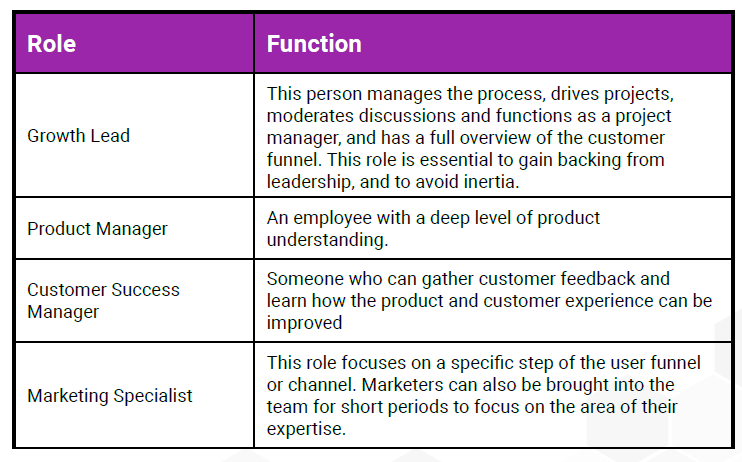
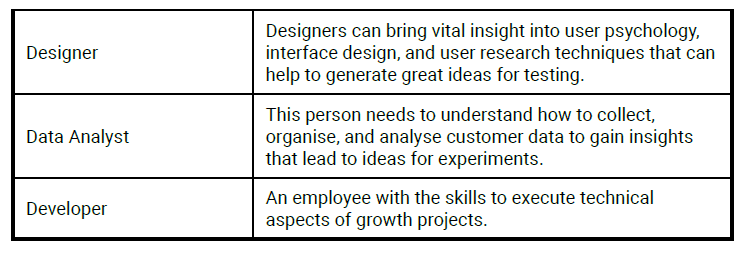
Reporting structures for growth teams
From interviewing Growth Leads at more than 20 companies, Andrew McInnes and
Daisuke Miyoshi were able to identify two distinct growth team models: Independent and
Functional.
The Independent Model
Uber and Facebook are two organisations using this approach. The teams are led by a VP
of Growth. In the case of Uber, this role reports to the CEO and leads 100+ people with
product, marketing, engineering, design, and data expertise. All working on growth.
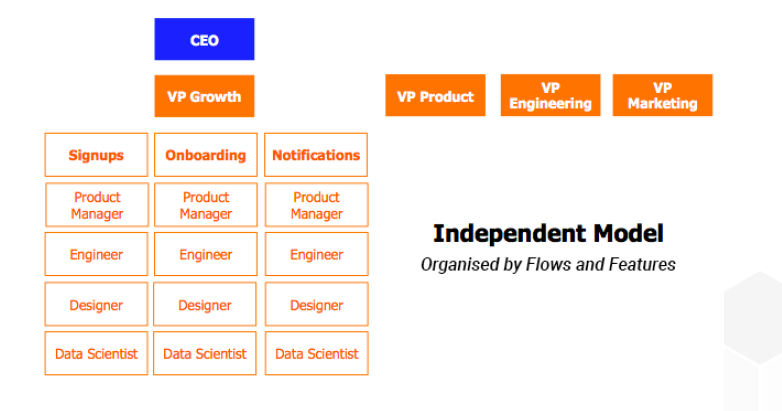
Uber uses this model to build strong team DNA around speed and
iteration. Uber values speed and iteration because they enable the
Growth team to build strong feedback loops into Uber’s product.
Andrew McInnes, Venture Executive, Mach49
Independent teams are stand-alone, rather than part of an existing product development
team, but report to a VP of growth, who then reports to a CEO or executive leader.
In this model, strong backing from senior management is required to navigate internal
frictions between product, marketing, design and engineering specialists.
The Functional Model
Referred to by Sean Ellis as the product-led model, involves people working on growth
initiatives reporting to functional heads of departments - product, engineering , and so on.
This model has three key features:
• Functional heads decide which growth initiatives are focused upon.
• These functional heads can balance growth initiatives against non-growth
initiatives
• The VP of Product is usually the functional head who owns growth.
As Sean Ellis highlights, this model can be a better choice for more established companies:
This model is easier to implement in an established firm or a later stage
start-up because it fits into the already existing management structure.This not only means that less reorganisation is required, but it helps
to mitigate friction in scheduling growth experiments into the existing
roadmap for testing product features in development.
Sean Ellis, Author, Hacking Growth
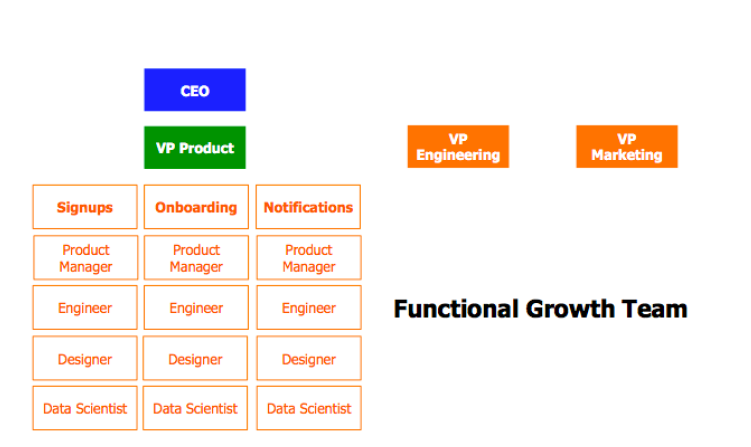
There is no right or wrong approach here, and McInnes and Miyoshi didn’t find any difference
in outcomes between the two structures.
While the Functional approach provides greater transparency thanks to a more balanced
approach toward growth, the Independent Model can produce greater speed and iteration,
though with less transparency.
In both cases, there still exists a tension between user experience and growth metrics i.e.
what works in terms of growth may happen at the cost of user experience.
The conclusion here is that the growth team model and reporting structure should be
chosen based on organisational fit. In addition, the success can depend on how well a
Growth Lead interacts and collaborates with teams.
Above all, success of any growth strategy, regardless of team structure, depends on string
backing and buy in from senior management.
The growth hacking cycle
The primary goal of the growth team is to set up an ongoing and continuous testing process,
and to build a rhythm and habit of testing. Every test you run provides opportunities to
learn, even if it doesn’t directly drive growth improvements.
Not every test leads to a change, but adds to the cumulative knowledge, with the team
learning how to accelerate growth through a well catalogued process.
This is building a rhythm of testing so the tests and feedback are all happening within
a matter of weeks, so that user feedback is up to data, and improvements can be made
quickly enough to drive greater business growth.
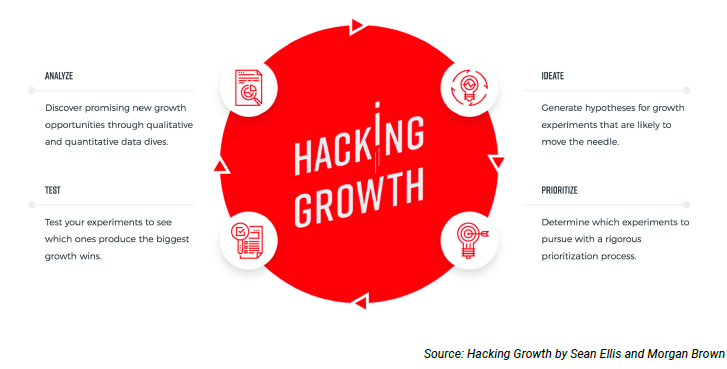
This is where Sean Eliss and Morgan Brown’s Growth Hacking Cycle provides a useful
framework:
• Analyse. Look into the data from the first wave of users to help you develop clear
and distinctive groups. You’ll be able to see what their behaviours are, where they
live online, what features they use, and what your best customers look like.
• Ideate. You need ideas for experiments to run which will help you improve your
core metrics. These brainstorms are a key to the growth hacking process and can
come from the team, the wider company, outside partners, and customers. You’ll
need to set up a project management system to coordinate the collection and
utilisation of ideas.
• Prioritise. The ICE system can help with this, it’s a way of selecting the most
promising experiments according to potential impact on growth.
• Test. Create a control group and an experiment group for each test to make sure
results can be tracked properly. Then set a 99% statistical confidence bar for each
test. Then log all results in a test summary and share them with the team.
This cycle can then be monitored by a weekly growth team meeting, where you can review
results and agree on actions going forward.
The ICE scoring system
This system can be used in meetings to review the results of tests and generate ideas for
further testing. It’s a simple but very useful method which helps to prioritise
ICE stands for:
• Impact: How much impact will the experiment, if successful, have on the key
metric?
• Confidence: How likely is it that the experiment will have a successful result?
• Ease: How easy is it to complete the experiment, and how much money or time
will be required?
This score should be used as a leading indicator of experiment feasibility, but ideas
shouldn’t be dismissed purely on this basis. It’s about prioritising the ideas which are likely
to have a greater impact.
Align team & testing around high impact
opportunities
After building the testing process and creating good testing habits, the next step is to
maximise impact.
To drive full impact, you’ll need to be able to test across the entire
customer journey (acquisition channels, new customer onboarding,
referral hooks in product, etc.). This is where things start getting hard.
The highest impact part of the customer journey is usually testing
across the first customer experience.
Sean Ellis, Author, Hacking Growth
There can be organisational barriers to this, and gaining permission to test will often require
permission from major stakeholders. This reinforces the importance of having buy-in at
senior levels for a growth hacking strategy.
A company-wide growth culture & mindset
High impact testing across the customer journey should start to deliver tangible business
results, and it’s these results which can drive greater buy-in and broader participation
across the business.
Effective communication of the process and the results you deliver is important here, in
order to keep the entire business onboard with this growth strategy.
No individual growth hacker or even a growth team can outperform a
company where everyone is mobilised to accelerate growth. Get started
on your path to breakout growth here.
Sean Ellis, Author, Hacking Growth
It’s useful to think of some of the skills required to build out your team. A growth hacker
needs a wide variety of creative and analytical skills that combine to create a single,
growth-hacking, decision-making machine.
These include:
• Understanding the company’s long-term goals
• Pinpointing issues that are hampering growth
• Choosing and prioritising goals relating to growth
• Identifying growth opportunities for the company
• Designing experiments to test whether new moves will impact the business
• Implementing projects to achieve growth goals
• Using data, analytics and other tools to inform decisions
• Utilising resources to improve growth
• Reporting on initiatives and projects to business leaders
• Replicating successful strategies at scale and in new markets.
Growth hacking case studies
Below are examples of brands using growth hacks to achieve rapid growth, and those that
have used the growth hacking mindset to maintain their success and drive further growth.
Hotmail
Often credited as the first growth hack in history, developers Sabeer Bhatia and Jack Smith
came up with an ingenious marketing ploy to drive the growth of free email service Hotmail.
After a brainstorming session, a single line and link was added to the end of each email
sent via Hotmail: ”PS: I love you. Get your free e-mail at Hotmail.”
Clicking on this link directed users to a registration page, where they were given the
opportunity to create their own free Hotmail account.
Hotmail took six months to reach a million users, then reached the second million after a
further five weeks. A year on, the company had 12m users when it was acquired for $400m
by Microsoft.
Airbnb
Airbnb used the existing popularity of Craigslist to grow its user numbers. The Airbnb team
looked for listings of vacation properties on Craigslist and emailed owners to suggest
listing on Airbnb too. Over time this process was automated.
Airbnb also gave an option for anyone listing their property on their site the opportunity to
post it on Craigslist. If they agreed, the listing would appear on both sites. Then, any clicks
on the Craigslist site would be linked back to the original posting on Airbnb.
In both cases, Airbnb piggybacked the Craigslist user base to grow its own.
Dropbox
Dropbox used incentives to grow its user through using word of mouth marketing.
Offering every user 500mb additional space for every friend recommended, they gained
access to new users through their friends and family. And it wasn’t a one time deal;
customers could gain up to 16Gb of additional free space, so people kept inviting new
people to the programme.
Instead of offering a ‘sign-up’ gift, the company turned every user into potential free
advertisers.
HubSpot
Creating a free tool that provides value is an excellent growth hack, one which HubSpot
used via its website grader tool. This tool helped marketers to evaluate their websites for
SEO optimisation, mobile usability and load speed to help them improve their websites.
Since users had to sign up to view their website report, it helped HubSpot grow its email
list. In 2015, the company’s founder and CTO Dharmesh Shah credited the website grader
tool as a key part of growing the company to 15,000 users and a $1.6 billion market value.
Booking.com
Booking.com epitomises some of the core principles of growth hacking; the lean startup
mentality, the data-driven approach, and the willingness to experiment constantly.
Furthermore, it still maintains this approach, even now it is well-established.
Booking.com began as a startup in Amsterdam in 1996, and is now the most visited hotel
website in the world.
It has achieved huge growth in both user numbers and revenue growth, including more
than a decade of consistent growth from 2007 to 2019 (only interrupted by the pandemic).
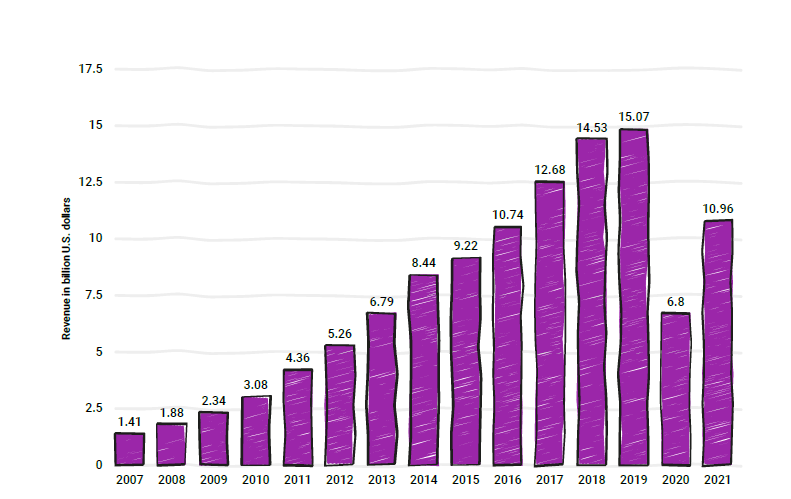
It has overtaken previously well-established hotel brands and shaken up the entire industry.
Many of its competitors failed to realise the potential of the internet for hotel and travel
bookings, but Booking.com’s startup philosophy enabled it to adapt quickly and take
market share from larger rivals.
Booking.com has prided itself on maintaining a startup mentality, and this is reflected in
the company’s approach to constant experimentation.
As Booking.com’s VP of Strategy and Corporate Development Rob Ransom explains:
We run 1,000 concurrent tests each day. Over time we’ve built up the
capability and the belief that experimentation at that level results in a
better outcome for the customers and the marketplace. Every digital
platform should be figuring out how to experiment, how they present
things on both sides of the marketplace.
Rob Ransom, VP of Strategy and Corporate Development
Just 10% of Booking.com’s experiments are a success, so the company created a ‘fail
budget’ to cover for the costs of these failed experiments. If there’s still room in the budget
it is seen as an indication that not enough risks were taken with these experiments.
There isn’t one simple growth hack which explains Booking.com’s success, but rather a
series of ‘hacks’ based around this lean startup philosophy.
Use of persuasion marketing
For example, Booking.com’s introduction of user reviews helped to solve choice paralysis
by helping customers decide. The site uses the principles of persuasion (as outlined by
Robert Cialdini) to drive bookings.
People like to follow the examples of others, and the hotel reviews are the social proof
which can persuade them to complete a booking, offering reassurance that others have
enjoyed the hotel.
It also uses another Cialdine principle, that of scarcity, to drive conversions.It’s the
perception that products are more attractive when availability is limited.
It’s common to see messages such as ‘only 3 rooms left at this price’, ‘5 people have
booked this hotel today’, and so on. These tell customers that they need to act fast or
miss out.
Summary
The practice of growth hacking may have been popularised by startups, often where the
entrepreneur was in charge of both product and marketing, and developed their growth
strategy from this perspective.
Growth hacking isn’t exclusive to startups or small businesses, rather it’s about mindset. In
traditional marketing departments, there’s a lot that can be learned from growth hacking.
With the infiltration of technology into marketing, marketers need to:
1. Learn how to use technology to achieve their goals.
2. Adopt agile working methods - testing and learning, iterating rather than planning
and executing rigidly.
Citations
1 Source: Scott Brinker, ‘Hacking Marketing’, chiefmartec.com, 2016. (https :// c h i e f
martec.com/2016 /02 /hacking -marketing -manage -marketing -software -world/)
2 Source: Sean Ellis, ‘Find a Growth Hacker for your startup’, Startup Marketing, July 26,
2010. (https://www.startup-marketing.com/ where-are-all-the-growth-hackers/)
3 Source: Sean Ellis, ‘The Growth Pyramid Revisited’, growthhackers.com, March 15, 2018.
(https://blog.growthhackers.com/ the-growth-pyramid-revisited-1ec8ff51877)
4 Source: Pisano Academy, ‘Sean Ellis Test: A Successful Method to Figure Out Product/
Market Fit’. (https://www.pisano.com/blog/sean-ellis-test-figure-out-product-market-fit)
5 Source: Lenny Rachitsky, ‘Choosing your North Star Metric’, Future, June 15, 2021. (https://
future.a16z.com/north-star-metrics/)
6 Source, Sean Ellis and Morgan Brown, ‘Hacking Growth’, Penguin, 2017 (https://
www.penguinrandomhouse.ca/books/545936/hacking -growth-by-sean-ellis-founder-ofgrowthhackerscom-
and-morgan-brown/9780451497215/excerpt)
7 Source: Andrew McInnes, ‘How do you choose the best growth team model?’, Medium.
com, October 19, 2015. (https://medium.com/swlh/how-do-you-choose-the-best-growthteam-
model-632ad5a85be9)
8 Source: Marc Schenker, ‘How to use Cialdini’s 6 Principles of Persuasion to boost
conversions’, CXL, June 29, 2019. (https://cxl.com/blog/cialdinis-principles-persuasion/)
